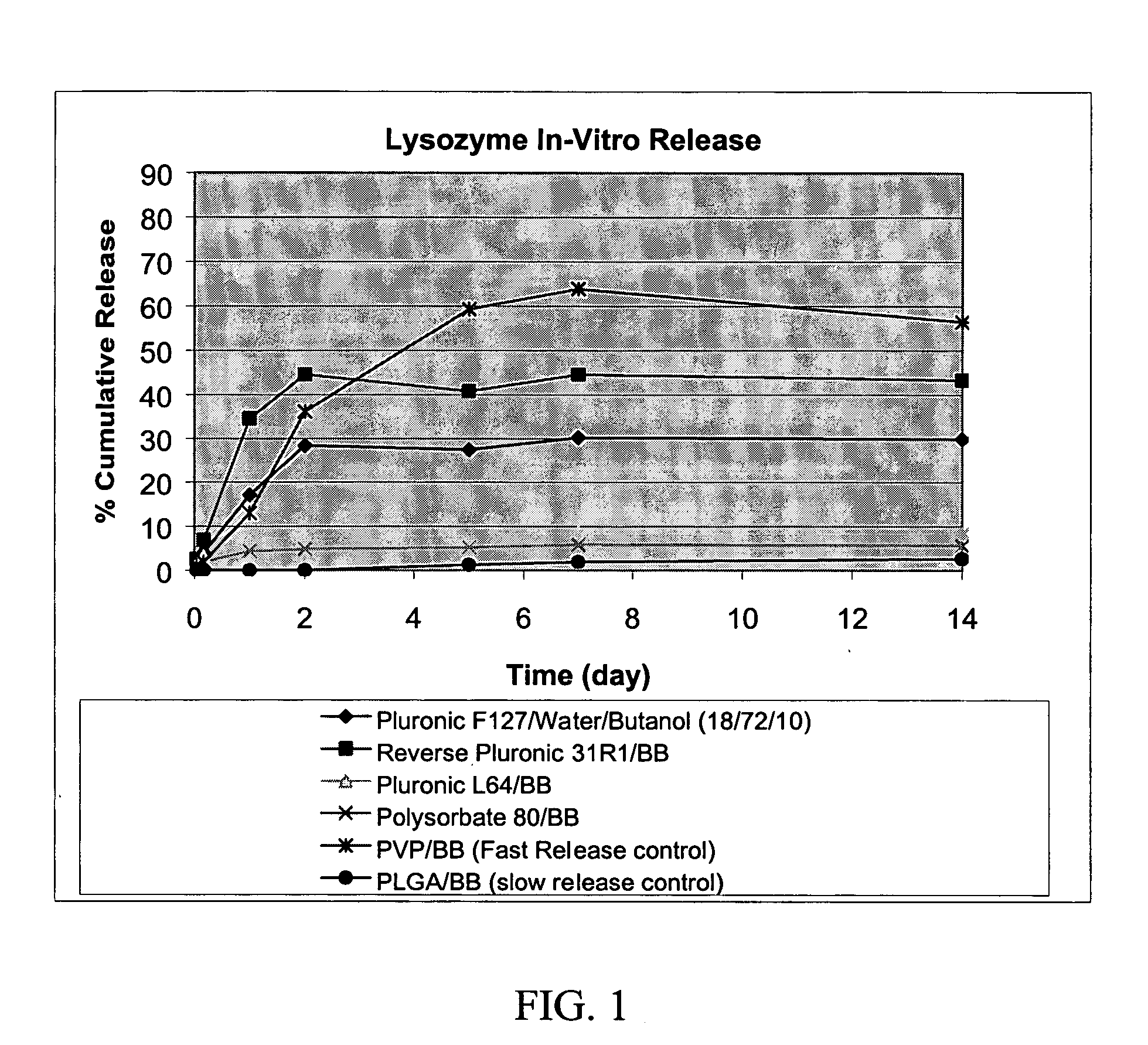Surfactant-based gel as an injectable, sustained drug delivery vehicle
a gel and surfactant technology, applied in the field of compositions, can solve the problems of protein and dna-based drugs degrading during the encapsulation process, less than ideal means for the sustained delivery of beneficial agents, and form a continuous film or solid implan
- Summary
- Abstract
- Description
- Claims
- Application Information
AI Technical Summary
Benefits of technology
Problems solved by technology
Method used
Image
Examples
example 1
Preparation of a Composition for the Sustained Delivery of Lysozyme
[0060] Sample Preparation
[0061] Four test samples and two control samples were prepared as follows. For each sample, a surfactant and a solvent in the weight ratio described in the table below were mixed in a 20 ml scintillation vial. The total weight of the surfactant and solvent in each sample was approximately 5 grams. The samples were then mixed using a Keyence Hybrid mixer for 10 minutes. Lysozyme (17 970 u / mgDW from Worthington) was then added to each vial in a dry box until the viscosity of the mixture increased to a level that was sufficient to allow the samples to be loaded into release cells, resulting in the addition of approximately 1 gram of lysozyme to each sample. The vials were tightly sealed and placed in a Keyence mixer for one minute. The vials were then stirred using an overhead mixer until a homogeneous mixture was obtained. A clear gel phase was obtained for the hydrogel formulation (Pluronic ...
example 2
Preparation of a Composition for the Sustained Delivery of Human Growth Hormone
[0064] Particles of recombinant human growth hormone are prepared by lyophilization of recombinant human growth hormone, sucrose, glycine, and phosphate in the amounts indicated below, followed by particle reduction and sizing, and / or spray drying. A gel is then prepared by mixing polysorbate 20 and benzyl benzoate (in the amounts indicated below) in a double plenatary mixer until the polysorbate 20 is dissolved in the benzyl benzoate. Polyvinylpyrrilidone in the amount indicated below is then slowly added to the polysorbate 20 / benzyl benzoate mixture form a viscous gel. The human growth hormone particles are then slowly dispersed into the gel to form a dosage form.
IngredientsFunctionComposition rangesPolysorbate 20Surfactant9.9%-69.9%Benzyl BenzoateSolvent9.9%-69.9%PolyvinylpyrrilidoneViscosity-building agent0.1%-1.0% (PVP)Human growth hormoneTherapeutic agent10% Sucrose / GlycineStabilizer8%PhosphateBu...
example 3
Preparation of a Composition for the Sustained Delivery of Lysozyme
[0065] A surfactant / solvent mixture containing 80% by weight of Polysorbate 80 (Croda) and 20% by weight of benzyl benzoate (Charkit) having a total weight of 10 grams is prepared in a 20 ml scintillation vial by mixing the two components with either an overhead mixer or a spatula. Lysozyme particles are prepared by spray drying a lysozyme solution, resulting in lysozyme particles of approximately 5 microns, or by grinding and sieving lyophilized lysozyme cakes, resulting in lysozyme particles of approximately 38 to 125 microns. One to two grams of lysozyme particles are weighed and fully dispersed in the surfactant / solvent mixture using an overhead mixer or spatula, which increases the viscosity of the formulation. The formulation is loaded into an in vitro release cell, and the release profile is obtained.
PUM
| Property | Measurement | Unit |
|---|---|---|
| Fraction | aaaaa | aaaaa |
| Fraction | aaaaa | aaaaa |
| Fraction | aaaaa | aaaaa |
Abstract
Description
Claims
Application Information
 Login to View More
Login to View More - R&D
- Intellectual Property
- Life Sciences
- Materials
- Tech Scout
- Unparalleled Data Quality
- Higher Quality Content
- 60% Fewer Hallucinations
Browse by: Latest US Patents, China's latest patents, Technical Efficacy Thesaurus, Application Domain, Technology Topic, Popular Technical Reports.
© 2025 PatSnap. All rights reserved.Legal|Privacy policy|Modern Slavery Act Transparency Statement|Sitemap|About US| Contact US: help@patsnap.com

